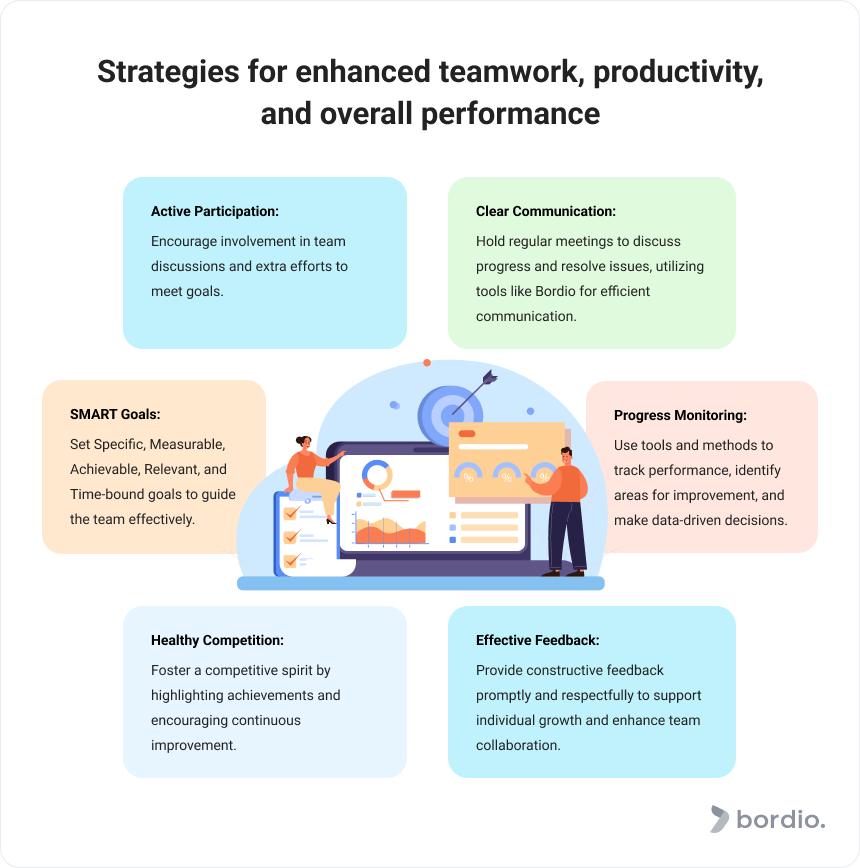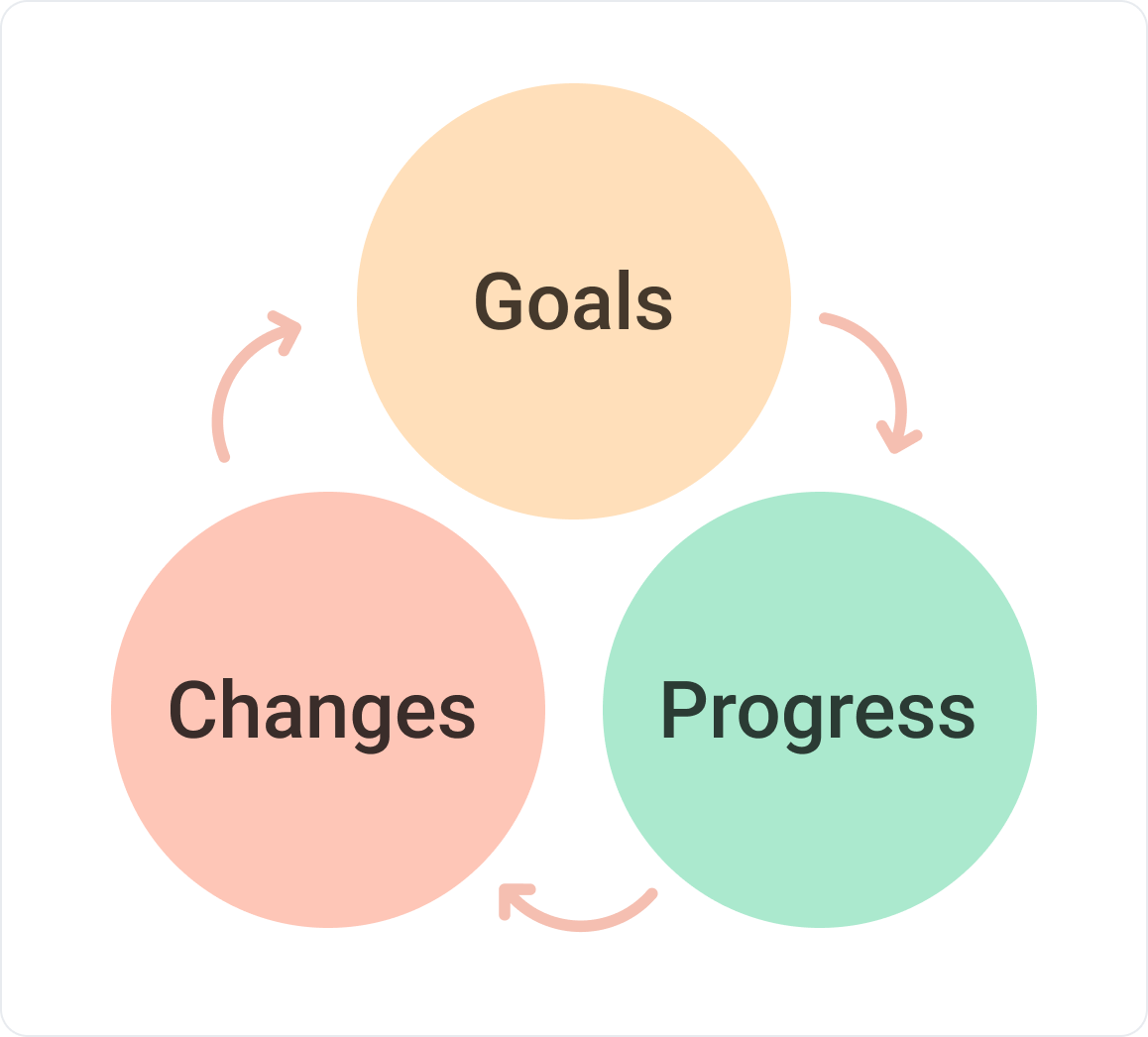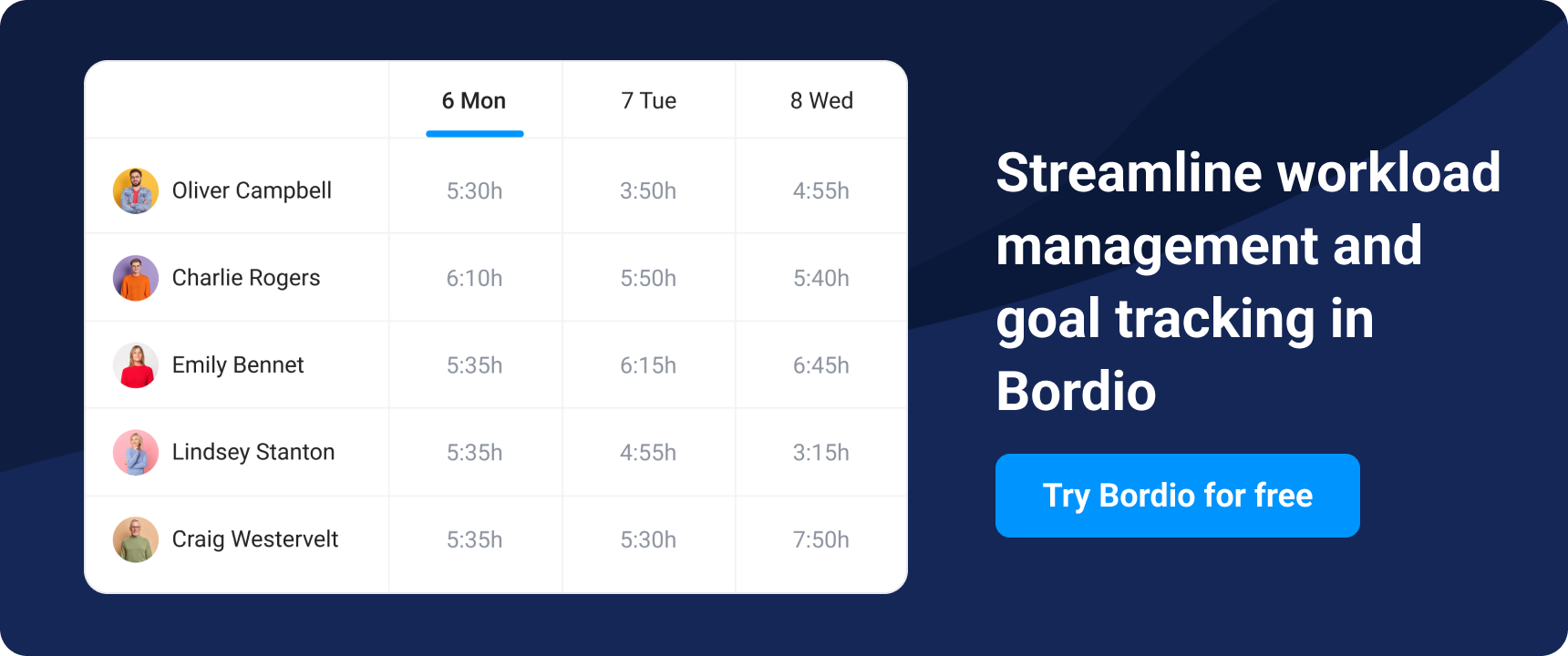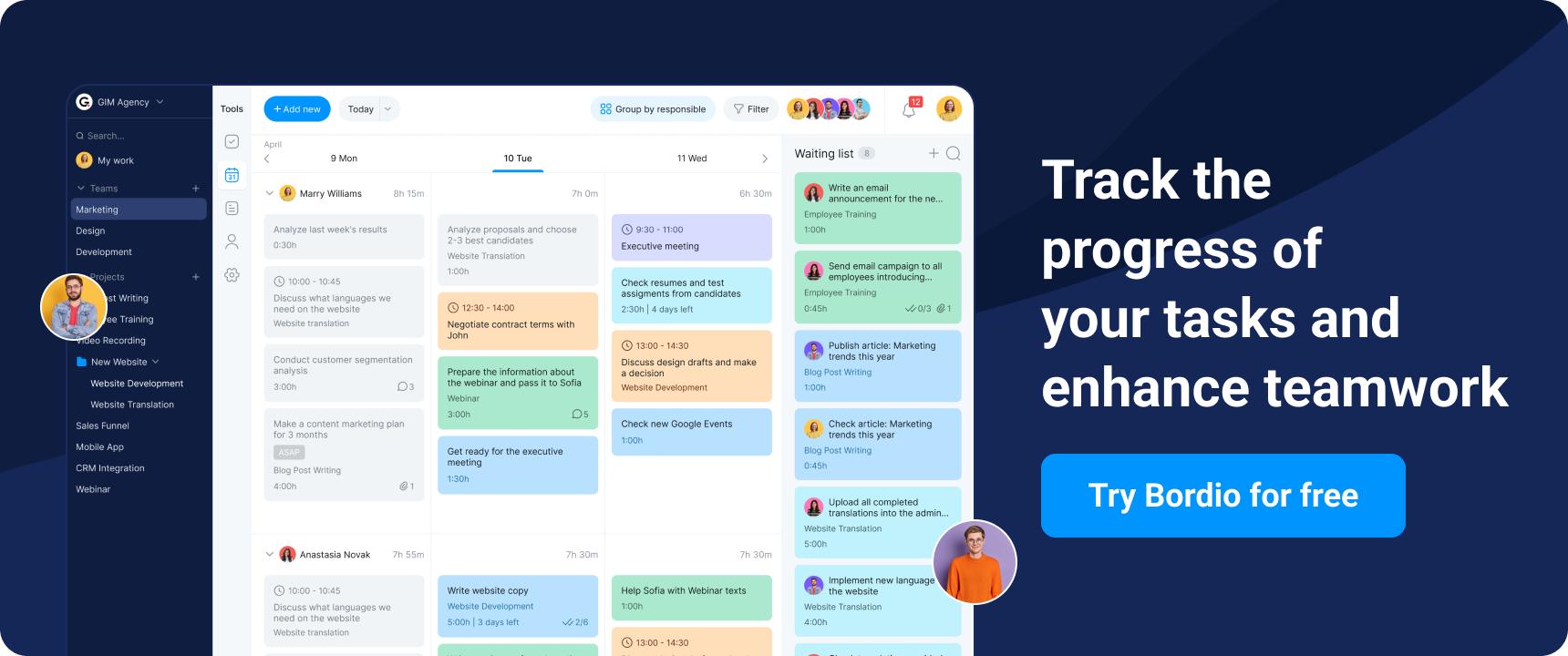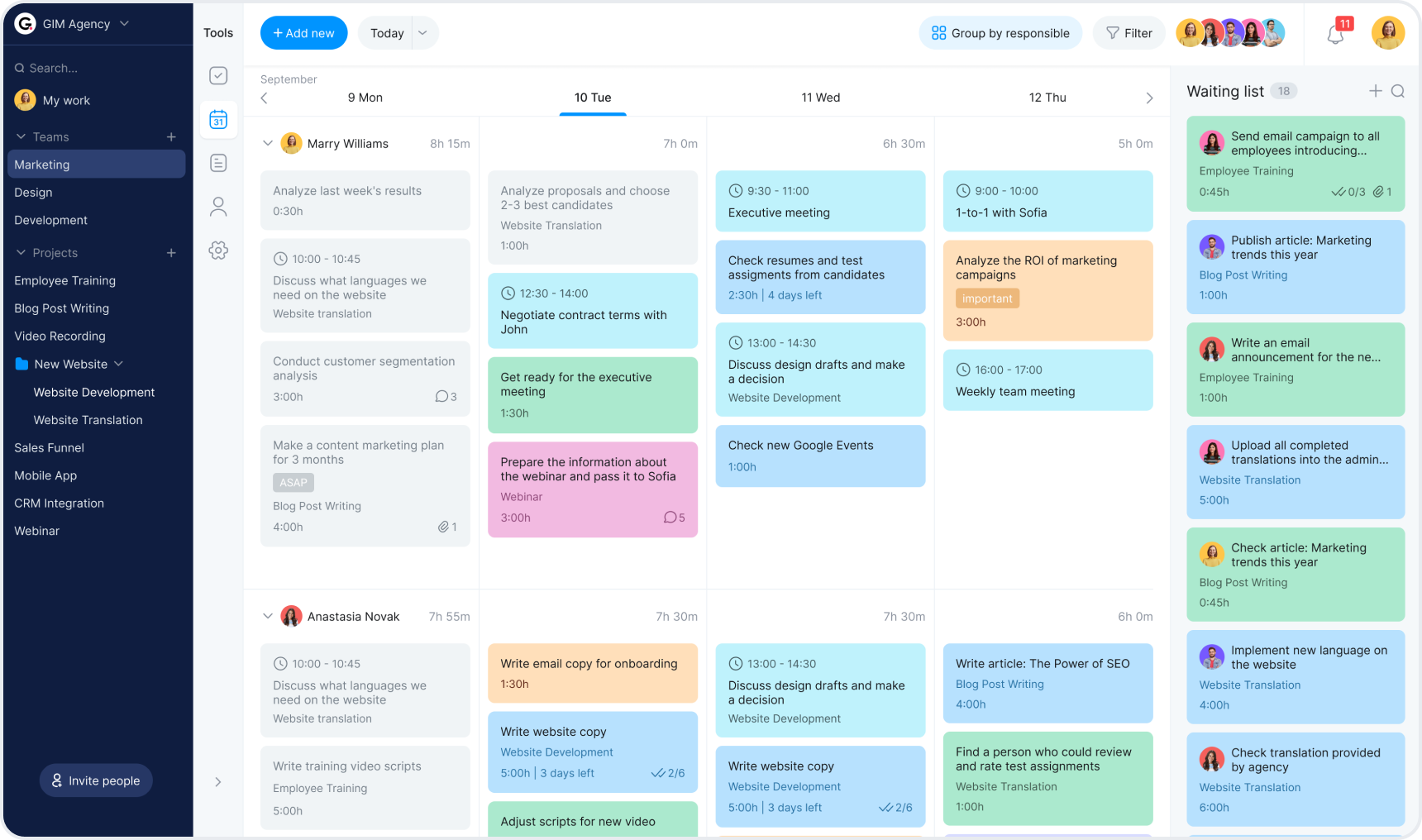Are you looking to boost your teams’ collaboration and results? Well, good management is critical! It’s all about keeping your company growing strong and staying on top.
Today, we will explore practical ideas companies can use to enhance employee and team performance. Whether it’s creating a culture where everyone feels responsible and empowered or using tech to make communication and project management smoother, we’ve got you covered. By understanding team processes, using online task planners, and implementing innovative project management styles, companies can hit their short-term targets and set themselves up for long-term triumphs.
So, let’s dive in together and discover how to unleash the full power of teams, pushing your company’s performance to new heights!
What is team performance management?
What exactly is employee performance management monitoring? We typically set goals, check their performance and progress to see if they are achieving those goals, give feedback, evaluate their performance, and either reward good work or help them improve it. Well, the same kind of thing happens with teams. It’s called team performance management. This involves setting team goals regularly, monitoring how the team is doing with those goals, and making changes to ensure everyone works together smoothly to complete the job.
Organizational leaders and managers do this stuff all the time – some are better at it than others. So, team performance management should be a regular part of running things. It’s kind of like making and then implementing an excellent strategic plan.
Understanding aspects of team performance management
Essential aspects of team performance management are divided into individual, team, and organizational activities. All of them are important for improving teamwork and achieving common goals.
Individual actions for each team member
Active participation: Everyone joins in on team talks, shares ideas, and pitches in with extra jobs to help the team do well. For example, someone might do more work to meet team goals.
Skill building: Individual team members always look for chances to improve their jobs. They might take online classes or courses to improve their communication or problem-solving skills.
Taking charge: Each team member owns up to their tasks. They finish what they must do on time, do it well, and help the team do well. For instance, someone might fix a problem in their area without being told by a boss.
Team actions
Regular communication: The team should gather frequently to discuss project details, share news, and resolve problems. Using a project task tracker helps track the progress of tasks in real time, which allows the team to be on the same page and adjust task execution in a timely manner. For example, they might meet weekly to see how the project progresses. It will also be helpful to conduct daily stand-ups to get feedback from each other and managers. Communication will also be vital if you work remotely. For example, in Bordio, a live chat opens when you open the task, where you can easily ask questions and clarify details.
Collaborative problem solving: The team must use everyone’s skills and ideas to develop new solutions. As soon as a problem arises, it must be raised at a meeting, and a solution must be found together. For example, they might brainstorm ways to improve a process.
Clear goals The entire team works together to achieve the same goals. You should set goals for the next few months and make a plan to achieve them as a team. You can set goals in the team management software and notify everyone in a meeting to ensure everyone is on the same page.
Organizational actions of team leaders
Training and Development Programs: The company invests in training programs to help employees work better together. For example, they might hold workshops on communication or teamwork.
Performance Recognition: The company praises and rewards teams that do well. It could be bonuses, awards, or just public thanks. For instance, they might discuss great team projects in meetings or newsletters. In a project management tool like Bordio, you can compare employees’ goals and present workload levels. It will make it easier to identify problems and praise achievements.
Resource Allocation: The company ensures that teams have what they need to do their jobs. It could mean giving them money, tools, or extra help. For example, they might give money for training programs or buy project management software to help teams work better together.
How to improve team performance management?
Now, let’s look at specific tips that will help you improve your team performance management and make your team successful.
Helping individuals perform better
In the ongoing discourse surrounding performance evaluation, there’s a growing sentiment favoring the cessation of grading individual performance. However, amidst this debate, one thing remains clear: feedback and recognition of individual successes continue to be crucial components in fostering personal and team growth.
While the emphasis may shift towards collective achievements, identifying high-performing individuals within teams remains essential. Understanding their contributions and impact on team success allows organizations to leverage their strengths effectively. Giving positive feedback and pointing out what each person does well helps create an environment where everyone feels valued. This strengthens teamwork and collaboration. Managers are really important in making this happen, so they must learn how to give and receive feedback effectively.
Also, letting team members give feedback to each other, like with 360-degree reviews, can provide valuable insights and help everyone keep getting better. By using these methods, companies can help everyone do their best work and help the whole team succeed together.
Power of feedback
Good feedback isn’t just about pointing out mistakes. It’s about giving guidance, support, and encouragement to help people grow in their jobs. Both employees and their bosses need to learn how to give feedback well. This means making sure the feedback is positive and understanding.
Feedback is also a big motivator. People feel meaningful and motivated when they know their hard work is seen and get helpful advice on improving. This leads to them being more involved in their work, doing a better job, and feeling happier.
To give feedback the right way, use the “sandwich” method. First, say something positive. Then, mention what needs improvement and end with another positive comment. This approach helps the person feel respected and not embarrassed while you come across as professional.
Give clear examples right when you notice something instead of just saying something general. When you need to point out something they can do better, do it in a way that won’t embarrass them, especially not in front of others. For example, in Bordio, you can immediately leave your feedback in the task’s chat, which can be accessed by simply clicking on it. And most importantly, be kind. Try to get where they’re coming from and how they feel. Being understanding and empathetic helps you get your point across nicely and effectively.
Implementing progress monitoring tools
One crucial aspect of progress monitoring is using various work management tools and methods to track performance. Implementing progress monitoring tools, such as an online project planner, is essential for any project or business endeavor. Tracking progress and performance metrics allows teams to assess their performance, identify areas for improvement, and make data-driven decisions to achieve their goals effectively.
The famous saying “You can’t improve what you don’t measure” underscores the importance of tracking progress. An experiment clearly illustrates this concept. It involved a team moving a ball from one corner of the room to another while holding hands. After completing the task in 30 seconds, the team realized the potential for improvement. Through continuous measurements and improvements, they gradually reduced the time to 25 seconds and then to 22 seconds. It demonstrates how measuring progress can help improve and optimize performance.
Dashboards and milestones are commonly used to provide visibility into the project’s status and ensure alignment with objectives. A project tracking board can also be a valuable tool, offering a clear overview of tasks, progress, and team responsibilities in real time, which helps keep everyone informed and focused on the project’s goals. Bordio, for example, offers a comprehensive platform for progress monitoring, allowing teams to create and allocate tasks, track time for them, and see the in-time progress of the project. In addition to these features for tracking team performance in Bordio, you can create future plans by moving tasks and events to the calendar and creating a to-do list for every day. If you already have some events in Google Calendar, you can connect it with Bordio to transfer all your existing events to the platform.
Promoting healthy competition
To explain the benefits of introducing healthy competition among team members, let’s revisit the example from the previous paragraph, where one team was tasked with moving a ball from one corner of the room to another while holding hands. Initially, only one team participated in this exercise. But what if there were several teams, each aware of the other’s results? After making several improvements, the first team was informed that another team had completed the task in 10 seconds. What do you think happened next? Upon learning about the competitor’s result, the team began brainstorming ways to outperform the other team and eventually devised a strategy that allowed them to complete the task in 9 seconds.
What can we learn from our story, and how can we use good competition at work? You don’t always have to talk about it directly. Instead, you can do what happened in our story: share how well other people are doing. For example, with a tool like Bodio, everyone can see how much work is being done and how fast others are doing their tasks. This helps everyone understand how much work there is and how quickly it’s getting done. Seeing this can make people want to do their best, just like their coworkers.
Tools such as dashboards make it easy to identify areas for improvement. By highlighting areas of poor performance or bottlenecks, teams can focus on effectively solving these problems.
Understanding team dynamics
When every team member feels involved and interested, they work better. A motivated team not only tackles challenges but also constantly aims to improve. It creates a vibe of excitement and positivity that boosts the work that gets done.
Leadership is critical to making this happen. A good leader sets a good example and encourages and helps team members. They build trust and respect, making each team member feel important and appreciated. Plus, the leader ensures everyone understands what the team tries to achieve and sets sensible goals.
Using SMART goals is a smart move here. SMART stands for Specific, Measurable, Achievable, Relevant, and Time-bound goals. When goals are set this way, team members know exactly what to aim for and how to get there. It makes them more confident and motivated, which helps the team work better together.
Work planning meetings
Planning is essential to team performance management. It involves establishing clear goals and priorities, ensuring a clear definition of tasks, and efficiently allocating resources. A project planner can help with this, by organizing tasks, tracking progress, and ensuring deadlines are met efficiently. Additionally, planning the expenditure of resources and time also involves scheduling meetings, creating a backlog for tasks, and analyzing productivity.
Optimizing the meeting schedule and agenda is something you need to pay attention to:
- Schedule meetings only if necessary and notify them several days in advance
- Set clear goals and agendas before the meeting
- Limit the duration of meetings
- Use technological tools planners
These simple tips will help you avoid wasting time.
Implementing time-blocking techniques
Time blocking is a way of managing your time. You divide your day into blocks and assign each block to a specific task or activity. Instead of tackling things as they arise, you plan your day ahead, setting aside time for different activities based on their importance.
This method works well because it gives your day structure and helps you focus. You can avoid getting distracted and work more efficiently by breaking your day into chunks and dedicating time to different tasks. It also helps you better balance work and life.
Using apps like Bordio can make time blocking even more accessible by sending reminders and helping you schedule your tasks. It allows users to create and organize their time blocks and track their progress, helping them stay on track and manage their tasks more effectively. Additionally, Bordio provides more valuable features, such as integration with Google Calendar, Notes, and teamwork features like live chat to discuss tasks.
Exploring alternative work formats
Alternative work formats like remote and hybrid setups let employees balance work and life better. They don’t have to commute and can choose when to work, making managing their time more accessible. This reduces stress and makes them happier.
Remote work is excellent because it reduces distractions from a regular office, helping employees focus and get stuff done faster. These setups also let companies hire top talent from anywhere, not just nearby. That means they can have a more diverse and skilled team. Plus, it saves money for both companies and employees. Companies spend less on office space and utilities, and employees save on commuting and work expenses.
Tip: If you’re a business owner or manager, you might be interested in learning how to interview to hire fast.
Improve but do not burnout
Continuous improvement is crucial for success. It means always striving to improve, developing new ideas, and being ready to adapt.
But while we’re busy trying to improve, we can’t forget to care for our employees. We need to make sure they don’t get too worn out and that they can keep being productive in the long run. It’s not just about pushing for better results; it’s also about creating a work environment where people feel supported and can balance their work and personal lives. Balance and motivation influence team effectiveness the most.
Improving team effectiveness without losing team members is not that hard. You must encourage team members to take breaks, show respect when people need time off, and offer help dealing with stress. Motivate team members, but don’t push people too hard. Decide on specific hours for work and stick to them. Let your colleagues and bosses know these hours so they know when to expect you to be available. Team members should take short breaks throughout the day to rest and recharge. They can use this time to step away from your desk, stretch, or do something relaxing. Set realistic goals for each day and break big tasks into smaller ones to make them more manageable.
Final Thoughts on Team Performance Management
Getting everyone to join in, learn new things, and take charge is critical to having a great team. But it’s not just up to the team – the company needs to back them up, too. Offering training, praising good work, and ensuring teams have what they need are all ways to make teams even more robust.
In short, managing team performance isn’t just about checking past work. It’s about always aiming to do better. By staying on top of things and helping teams grow, companies can get the best out of their teams and reach higher achievements.

